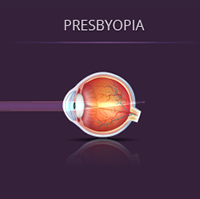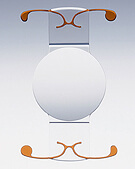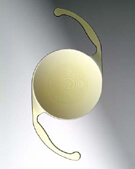Presbyopia
INTRODUCTION
During childhood, people with normal vision have the ability to focus on objects as close as their nose and also on objects very far away. They can rapidly, without conscious thought, switch focus from near to far vision and back again. This is called accommodation and is accomplished by the flexing of the internal lens.
As each year passes, that ability to focus and to switch focus decreases. By the time most people reach their forties, they need an aid, such as reading glasses or bifocals, to focus on objects close up. This condition is called presbyopia.

Considered a natural part of aging, presbyopia occurs when the internal crystalline lens loses its flexibility. Presbyopia may seem to occur suddenly, but the actual loss of flexibility takes place over a number of years.
Presbyopia can be present in combination with other types of refractive errors such as myopia, hyperopia and astigmatism. Eventually everyone, if they live long enough, will need to wear glasses.
Long before an individual is aware that seeing close up is becoming more difficult, the lenses in the eyes have begun losing their ability to flatten and thicken. Only when the loss of elasticity impairs vision to a noticeable degree is the change recognized. Presbyopia usually becomes noticeable in the early to mid-forties.
HOW IT WORKS
The crystalline lens is responsible for your ability to see something far away and then to focus on something close to you, regardless of whether you are wearing corrective lenses or have had refractive surgery.
Located inside your eye just behind the pupil and iris, the crystalline lens is controlled by tiny muscles. These muscles push or pull on the lens to alter its curvature and thereby change its focal power. When the interior lens is the most flat, the lens is best for distant viewing. As the interior lens rounds, it is best for close vision.
Gradually over years, the lens becomes less flexible and the muscles become less powerful. The lens can no longer accommodate and presbyopia is the result. You can no longer change focus from near to far, and will need reading glasses or bifocal lenses.
TREATMENTS
There are two ways to describe myopia. One is that you cannot see things far away very well. The other is that you can see things close very well. People with a small amount of myopia can simply remove their distance-correcting glasses to read. However, people with previously normal vision, those who are hyperopic, or those who wear contact lenses for myopia may need to use reading glasses for close work such as reading, using a computer, or sewing.
Bifocals and trifocals can also be used to provide both near and far vision without having to constantly put on and take off a pair of glasses or switch between two pairs of glasses. Progressive lenses are bifocals or trifocals without the telltale lines across the lenses. Another option, known as monovision, is often effective & available for some people with presbyopia.
LENS IMPLANTS THAT TREAT PRESBYOPIA:


LASIK FOR HYPEROPIA
Presbyopia typically occurs at around age forty, regardless of whether one undergoes laser vision correction.
When it comes to LASIK and presbyopia, it might be helpful to imagine what happens when you use manual focus binoculars. If you adjust the lens to bring a distant object into focus, that object becomes very crisp while the images closest to you become fuzzy. Conversely, if you adjust the lens to bring an object in the foreground into focus, that object becomes very crisp while the background becomes fuzzy. If you focus on the middle ground, you can see the foreground and the background relatively well, but neither perfectly.
If you are over forty years old and are corrected in both eyes with LASIK for excellent distance vision, you will have to wear reading glasses for close up work. However, many presbyopic patients enjoy the benefits of LASIK monovision. The dominant eye is reshaped for distance vision. The non-dominant eye is left slightly nearsighted to assist reading. Typically, the brain effortlessly adjusts to the difference and vision seems normal regardless of the focal point. Discuss this with Dr. Seibel, to see if you are a candidate.